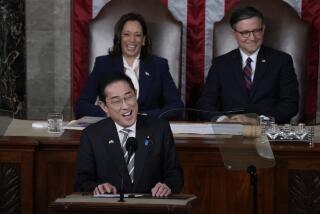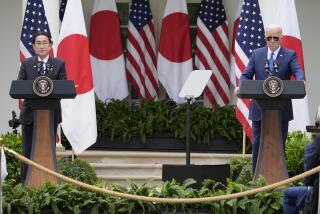U.S. and Japan Discuss Dollar--to Little Avail
- Share via
WASHINGTON — In the highest-level meeting of U.S. and Japanese officials since the dollar turned cool, the yen heated up and trade tensions soared, Treasury Secretary Robert E. Rubin and his Japanese counterpart agreed Sunday that it is time to find a way to stop the dollar’s decline.
But, offering a vivid demonstration of the wide gap between the two 800-pound gorillas of trade and finance, they agreed on little else--including any sort of coordinated attack on the problems that have made international economics more chaotic.
At a meeting in Sanur, on the Indonesian resort island of Bali, Rubin turned aside a Japanese proposal to boost the role of the yen as a principal foreign reserve currency, a role played throughout the world by the dollar.
Referring to the proposal from Japanese Finance Minister Masayoshi Takemura, presented when the two met before an annual conference of U.S. and Asian finance ministers, Rubin said his response was a flat “no.”
“I said we have large, deep and effective capital markets and we had no need to do debt denominated in the currency of another country,” Rubin said.
An economic revitalization plan that Japan unveiled Friday also got the same sort of cool reception at the meeting, with U.S. officials making it clear that they expect Japan to make a bigger effort.
The plan calls for greater imports of foreign housing construction material, lower public utility rates and greater economic stimulus by the government. In a coordinated move, the Bank of Japan lowered its official discount interest rate by three-quarters of a percentage point, to a record low of 1%.
The measures are intended to spark a consumer-based economic revival, which would increase demand for imported products.
The effort was part of a plan to cut the current account surplus--a wide measure of trade in goods and services--and to reduce burdensome government regulations that foreign companies complain limit their access to Japanese customers.
But so far, U.S. officials have looked askance at the deregulation effort in general. Friday’s plan included no targets for cutting the Japanese trade surplus--which is seen as playing a crucial role in pumping up the yen in relation to the dollar--or for specifically increasing imports.
Although many markets around the world were closed for the Good Friday holiday, those open showed no excitement about the Japanese plan, and it had little appreciable impact on the yen and dollar in limited trading.
Against that vote of nearly no confidence, Rubin and Takemura met for an hour before the conference of the Asia Pacific Economic Cooperation forum.
“We all agreed that more stable exchange rates are in the interests of the world,” Rubin said. But there was no detailed agreement about specific currency problems in either his meeting with Takemura or in the session of the 18 members of the forum.
Reflecting the sense that Japan needs to take greater action, a senior Treasury official said the meeting with Takemura “focused on what Japan needed to do.”
“The Japanese came in and they acknowledged that the market had not received their economic plan very well,” the official said.
Takemura was said to have promised that more specific plans will be produced within two months.
Since the beginning of the year, the yen has appreciated 17% against the dollar, making Japanese goods more expensive in the United States. This can help bring the two nations’ trade closer to a balance, but it also is making Japan a storehouse for dollars.
The strength of the yen is an issue for nations throughout Asia as well as the United States, because many of them ran up sizable debts in the 1980s, borrowing yen to finance large construction projects, and they are now faced with paying back the loans in an expensive currency.
Overall, Japan ran up a $118-billion trade surplus with the world in the fiscal year that ended March 31 and a $65.7-billion trade surplus with the United States in 1994--roughly 60% of it in the auto trade.
U.S. and Japanese officials are moving talks in Washington to a higher level this week as they try to reach an agreement on increasing the sales of U.S. vehicles, and automotive parts, in Japan.
White House officials have said that the Clinton Administration has prepared a list of trade sanctions on billions of dollars’ worth of Japanese goods imported into the United States that will be imposed if agreement is not reached soon.
Rubin, reporting on his session with Takemura, said the two agreed on the need to develop institutional, international responses to such crises as the one that racked Mexico as the peso tumbled and international investment fled. Such problems, and the potential responses by such organizations as the International Monetary Fund, are likely to be high on the agenda when the Group of Seven nations--Britain, Canada, France, Germany, Italy, Japan and the United States--meet for their annual economic summit in June in Halifax, Canada.
In particular, Rubin said he and Takemura agreed that it is necessary to develop a system to make budding crises more apparent to international monitors so they can be eased before reaching a crisis stage.
More to Read
Inside the business of entertainment
The Wide Shot brings you news, analysis and insights on everything from streaming wars to production — and what it all means for the future.
You may occasionally receive promotional content from the Los Angeles Times.










